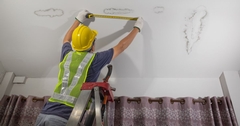Roof Leaks and Water Damage: Identifying the Source and Repairing the Damage

A leaking roof can be a homeowner's nightmare, leading to a cascade of problems that range from water damage to structural issues. Identifying the source of a roof leak and promptly repairing the damage is crucial to preserving the integrity of your home. In this blog post, we'll explore the common causes of roof leaks, methods for identifying the source, and essential steps for effective roof leak repairs.
Common Causes of Roof Leaks
Roof leaks can occur for various reasons, each demanding a unique approach to repair. Common causes include damaged or missing shingles, deteriorated flashing around chimneys or vents, clogged gutters, and aging roofing materials. Identifying the specific cause is the first step in addressing a roof leak effectively.
Interior Signs of Roof Leaks
Detecting water damage inside your home is often the first indication of a roof leak. Stains on ceilings or walls, peeling paint, or mold growth are telltale signs. A thorough inspection of your home's interior can help pinpoint the location of the leak and guide your repair efforts.
Exterior Inspection
Conducting an exterior inspection is crucial in identifying visible signs of roof damage. Look for missing or damaged shingles, cracked flashing, and areas where water might pool. Pay attention to the condition of the roof around chimneys, skylights, and vents, as these are common trouble spots.
Attic Examination
The attic is an often-overlooked space that can provide valuable insights into the source of a roof leak. Check for water stains, damp insulation, or signs of mold growth. Follow the trail of water damage to identify the entry point of the leak. Keep in mind that roof leaks may not always appear directly above the water stains.
Roof Penetrations and Flashing
Roof penetrations, such as vent pipes and chimneys, are vulnerable areas for leaks. Inspect the flashing around these penetrations for cracks, gaps, or deterioration. Damaged flashing is a common culprit for roof leaks, and replacing or repairing it can prevent further water infiltration.
Shingle Inspection
Damaged or missing shingles compromise the protective layer of your roof. Conduct a thorough shingle inspection, looking for signs of curling, cracking, or granule loss. Replace damaged shingles promptly to prevent water from seeping into the underlying layers of the roof.
Gutter and Downspout Maintenance
Clogged gutters and downspouts can contribute to roof leaks by causing water to back up and pool on the roof. Regular gutter maintenance, including clearing debris and ensuring proper drainage, is essential in preventing water damage. Addressing this issue can help safeguard your roof and the entire structure.
DIY Repairs vs. Professional Assistance
While some minor roof repairs can be handled as DIY projects, extensive damage or complex issues may require professional assistance. If you are not comfortable working at heights or if the damage is beyond your expertise, it's advisable to seek the services of a qualified roofing professional. They can conduct a comprehensive assessment and provide effective solutions.
Temporary Fixes
In cases where immediate repairs are needed, consider temporary fixes to prevent further water damage. Tarping damaged areas or applying roofing sealant can provide a temporary barrier until a more permanent solution can be implemented. However, it's crucial to follow up with a complete repair to address the root cause of the leak.
Professional Roof Inspection
Regular professional roof inspections proactively identify and address potential issues before they escalate. Roofing professionals have the experience and expertise to conduct thorough inspections, detect hidden problems, and recommend preventive measures to extend the life of your roof.
Roof leaks and water damage pose significant threats to the structural integrity of your home. Identifying the source of a roof leak and promptly addressing the damage are essential steps in mitigating potential risks. Whether through interior examinations, exterior inspections, or attic assessments, a systematic approach to leak detection enables homeowners to pinpoint the problem and take appropriate action. Whether opting for DIY repairs or seeking professional assistance, addressing roof leaks promptly is key to preserving the longevity and resilience of your home's roofing system.